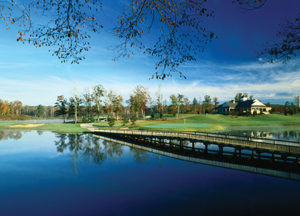Green Gold: Golf in Alabama
Posted on October 31, 2016 by bob in Features
Adapted from an article by James R. Hansen (Photos as noted)
The Robert Trent Jones Golf Trail is a series of championship courses across Alabama based on the designs of legendary American golf-course architect Robert Trent Jones, Sr. The system, which includes resorts, spas, and dining facilities, is part of a massive financial investment and economic development project sponsored by the Retirement Systems of Alabama. Praised widely by critics and players alike for the affordability and the quality of play, the Trail has been cited in the media as one of the world’s top-ten trips and featured prominently in the book Fifty Places to Play Golf Before You Die by Chris Santella.
The plan for the golf trail was originally conceived by David G. Bronner, a Minnesota native who in 1973 took over as chief executive officer of the Retirement Systems of Alabama, the pension funds for public employees. Bronner, who earned a law and doctoral degree from the University of Alabama, initially concentrated on traditional investments. By the mid-1980s, however, in order to diversify the fund and bring more business and industry to the state, he embarked on a highly unusual strategy.
Inspired by Field of Dreams, a 1989 Hollywood film in which a farmer builds a baseball field to attract tourism, Bronner decided to fund construction of a series of championship-caliber public golf courses, seeing the courses as a fulcrum for boosting tourism, attracting retirees, and spurring economic growth in Alabama. He brought in Robert “Bobby” Vaughan, former director of golf at Tanglewood Golf Club in Clemmons, North Carolina, to put together a design team for the project. Vaughan formed the SunBelt Golf Corporation and, with Bronner’s assistance, began forming alliances with municipalities, corporations, and private developers throughout the state to secure donations of prime land for the courses along the state’s interstate highway system. When the property was secured, SunBelt began hiring experts from the U.S. golf industry to develop, construct, and operate what would be the largest single golf-course construction project ever undertaken at one time anywhere in the world.
Early on, Bronner and Vaughn seized on the idea of establishing a “trail” of courses that would meander across the state, from the foothills of the Appalachians in north Alabama to the Gulf of Mexico in the south. Winter residents of the Gulf Coast heading south could play golf as soon as they crossed the Tennessee line and continue all the way to Mobile Bay. The next challenge was to decide on a name for the trail that golfers from around the world would instantly recognize and associate with championship golf. They settled on Robert Trent Jones, arguably the premier golf-course architect in the world. In a career that spanned nearly 70 years, Jones designed or redesigned almost 500 top-flight golf courses in 45 states and 35 countries. Jones’s belief that every golf hole should be “a hard par but an easy bogey” exerted a profound impact on American golf in the second half of the twentieth century.
Jones visited the state and inspected several sites. Although in semi-retirement, he agreed to tackle the project, leaving most of the detailed design work to his principal associate, Roger Rulewich. The Trail courses reflected all the essential elements of Robert Trent Jones’ personal design philosophy, in which “risk-reward” shots became a staple of modern golf. The golf courses on the Trail would live up to Jones’ highest standards, offering genuine championship layouts designed to stand the test of time and pose major tests for generations of golfers. Aspiring to a level of difficulty that even surpassed the expectations of Jones himself, SunBelt president Bobby Vaughn encouraged Jones’ associate Roger Rulewich to make the trail courses as difficult as possible, while at the same time offering value to players at various skill levels.
A wide variety of teeing locations, pegged to ability level rather than age or gender, enabled golfers to play the courses at varying distances. This flexibility was needed to make the Trail a satisfying golfing experience for a mass market, an experience that would challenge the best golfers in the world, yet at the same time allow an enjoyable outing for casual and beginning golfers. Adding to the flexibility was the inclusion of so-called short courses, highly challenging circuits located at seven of the 11 trail facilities. At least three of these courses have merited consideration as the most challenging par-3 courses in the world.
The Robert Trent Jones Golf Trail opened in 1992 with four courses:

Grand National, Opelika/Auburn (54 holes). Photo by Michael Clemmer.

Hampton Cove, Huntsville (54 holes). Photo by Meg McKinney.

Magnolia Grove, Mobile (54 holes). Photo by Michael Clemmer.

Oxmoor Valley, Birmingham (54 holes). Photo by Meg McKinney
The following year, three additional courses opened:

Highland Oaks, Dothan (54 holes). Photo by Michael Clemmer.

Cambrian Ridge, Greenville (54 holes). Photo by Michael Clemmer.

Silver Lakes, Anniston/Gadsden (36 holes). Photo by Dan Brothers.
The system has since expanded with four more sites:

Capitol Hill, Prattville/Montgomery (54 holes). Photo by Mark Tucker.

Ross Bridge, Hoover (18 holes). Photo by Michael Clemmer.

Lakewood, Point Clear (18 holes). Photo by Tad Denson.

The Shoals, Florence (36 holes). Photo by Meg McKinney.
The Trail has earned nearly universal acclaim, winning accolades and awards from numerous golf and tourism magazines, transforming Alabama into one of the world’s top golf destinations.
Information courtesy Encyclopedia of Alabama, www.encyclopediaofalabama.org.
The Economics of Golf
By Mark Fagan
The late Arnold Palmer was a gentleman in the “Gentleman’s Game.” He inspired countless people worldwide to take up golf, not only through his winning style of play, but with his outgoing personality. Even if you’re not a golfer, as an Alabama resident you benefit from the increased interest Palmer brought to the game, and the economic impact of the Robert Trent Jones Golf Trail (RTJ).
Since the Trail was created, tourism spending has increased from $462 million to $1.4 billion in Montgomery, Autauga, Elmore, Lee and Butler counties alone. Direct and indirect travel-related jobs in these counties have risen from 8,712 prior to the Trail’s inception, to 21,088 jobs in 2015, producing $578 million in earnings. Overall, tourism spending associated with the RTJ Trail – both golf courses and accompanying hotels – was $7.5 billion in 2015.
Whether or not you play the game, golf has provided Alabama with an influx of tourists – national and international – enjoying the courses, the lodging, the dining, and the hospitality for which we’re famous. Since 1993, RTJ courses have hosted 12 million rounds of golf, half of which were played by out-of-state golfers. Courses on the Trail have also hosted 32 LPGA, Senior PGA, and PGA tournaments, with 350 hours of worldwide TV coverage of these tournaments being seen on the Golf Channel, co-founded by Arnold Palmer.
Adding to the Trail’s reputation, Danny Willet, winner of the 2016 Masters, played two years for Jacksonville State University on their home course at Silver Lakes, a Trail site. Silver Lakes has many similarities to Augusta National – latitude, weather, wind, topography, course design – no doubt preparing Willet to excel at the Masters, in effect, bringing golf in Alabama full circle.
Mark Fagan was a professor at Jacksonville State University for 32 years, where he researched and published papers on retirees and economic development. His latest book is “The Robert Trent Jones Golf Trail: Its History and Economic Impact.” To contact Dr. Fagan, e-mail mfagan@jsu.edu.









